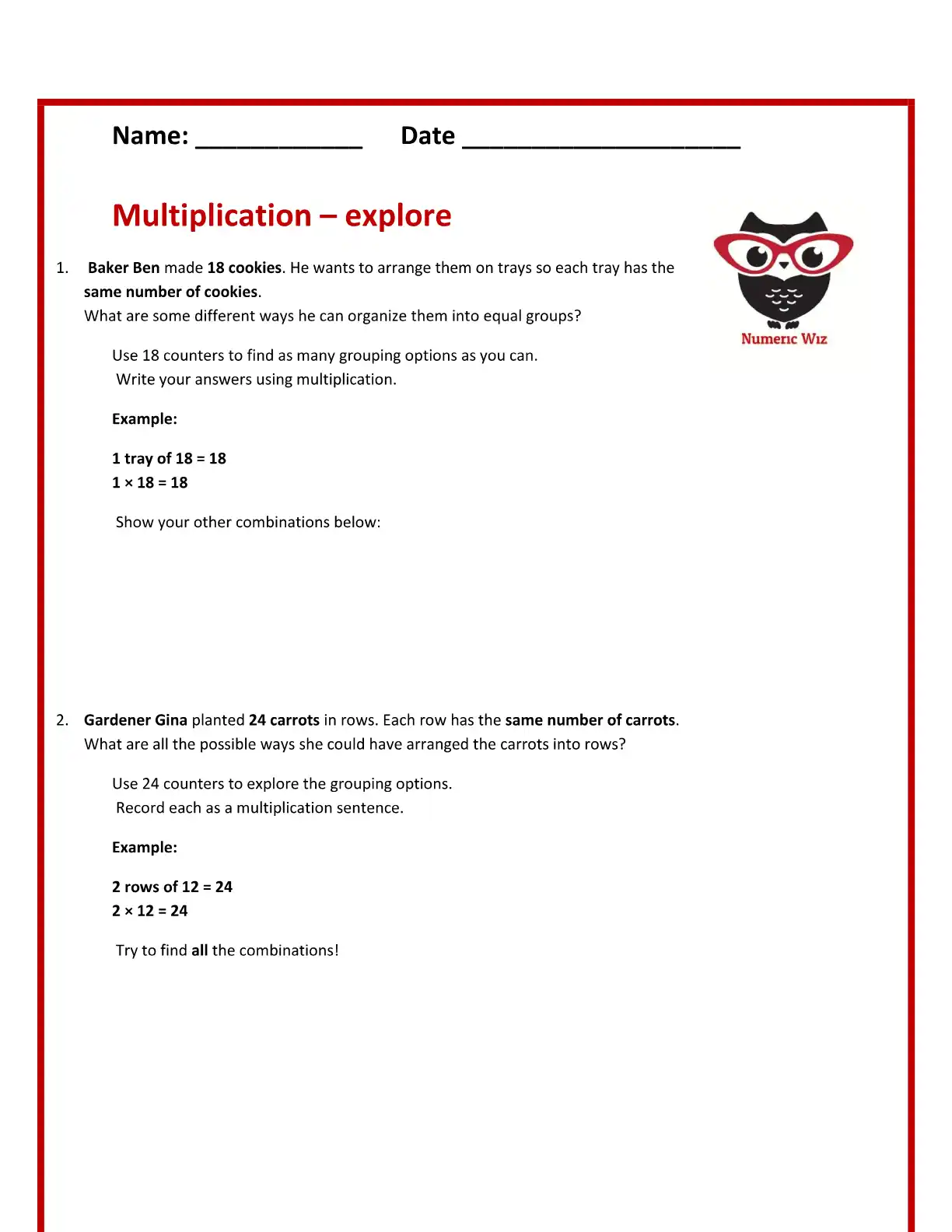Explore multiple ways to group objects equally
Write multiplication sentences to match groupings
Understand multiplication as repeated addition
Develop early number sense and pattern recognition

Have you ever tried counting large sets one by one? It feels slow and tiring. That’s where multiplication comes in. By using equal groups, students can see multiplication not as a tough calculation, but as a smart way to make repeated addition faster. This method builds strong math foundations and reduces confusion.
In simple words, equal groups mean dividing objects into sets where each group has the same number of items. For example, 3 groups of 4 apples = 12 apples total. Instead of adding 4 + 4 + 4, multiplication lets us say 3 × 4 = 12.
This practice is part of early multiplication learning, usually introduced in Grades 2 and 3 under ixl (Common Core Standards), where students learn to model multiplication through equal groups, arrays, and repeated addition.
Equal groups worksheets are not just exercises; they help students:
Recognize patterns in multiplication.
Connect repeated addition with multiplication facts.
Build problem-solving confidence.
By practicing step-by-step, learners develop fluency that makes larger multiplication problems much easier later.
Equal groups are all around us in daily life:

5 baskets each with 6 mangoes = 30 mangoes.
4 cars, each with 4 wheels = 16 wheels.
8 chairs in each row of a hall, with 5 rows = 40 chairs.
These situations show that multiplication is not just numbers on a page—it’s part of everyday problem solving.
Teachers often begin with hands-on activities using counters, blocks, or pictures. First, students group objects manually. Next, they shift to drawing groups on paper. Finally, they connect these groups with multiplication sentences like 3 × 5 = 15. This gradual scaffolding ensures deeper understanding rather than rote memorization.
Draw and Count: Students draw groups of circles to match multiplication problems.
Color Matching: Each equal group is shaded in different colors.
Game Time: Use flashcards with “groups of” problems.
These activities make worksheets fun while reinforcing the equal groups concept.
Think about shopping. If you buy 3 packs of juice, and each pack has 6 boxes, you don’t open them to count individually. Instead, you multiply 3 × 6 to get 18. Equal groups make life easier in real-world tasks—like planning chairs for guests, counting pencils in bundles, or dividing snacks among friends. Understanding multiplication this way shows students why it matters outside the classroom.
Lena has 18 toy cars. She wants to park them in rows in her toy garage, with the same number of cars in each row.
How many different ways can she arrange the toy cars in equal rows?
Write each as a multiplication sentence.
Step 1: Start with the number 18.
We're looking for all the ways to group 18 equally.
Step 2: Try different group sizes and check if 18 can be divided evenly.
| Row size | ➗ Can 18 be divided evenly? | ✔ Multiplication sentence |
|---|---|---|
| 1 car per row | 18÷1=18 ✅ | 1×18=18 |
| 2 cars per row | 18÷2=9✅ | 2×9=18 |
| 3 cars per row | 18÷3=6 ✅ | 3×6=18 |
| 4 cars per row | 18÷4=4.5 ❌ | Not a whole number |
| 5 cars per row | 18÷5=3.6 ❌ | Not a whole number |
| 6 cars per row | 18÷6=3✅ | 6×3=18 |
| 9 cars per row | 18÷9=2✅ | 9×2=18 |
| 18 cars per row | 18÷18=1 ✅ | 18×1=18 |
1×18 
2×9
3×6
6×3
9×2
18×1
Multiplication is equal groups
There’s more than one correct way to arrange items
Writing multiplication sentences helps build patterns
Teachers often say equal groups worksheets help struggling students build clarity in multiplication. Instead of memorizing tables, learners understand the “why” behind multiplication. Students also report more confidence because pictures and groups feel less abstract than plain numbers. This feedback proves worksheets are effective in both classroom and home practice.
Download the worksheet, solve it, and upload your answers to our “Evaluate Your Work” page. Our awesome teachers will check it and send feedback just for you! Homework has never been this fun—or this helpful!
Make learning meaningful with this classroom-ready worksheet — available now at NumericWiz.com.
For a limited time
